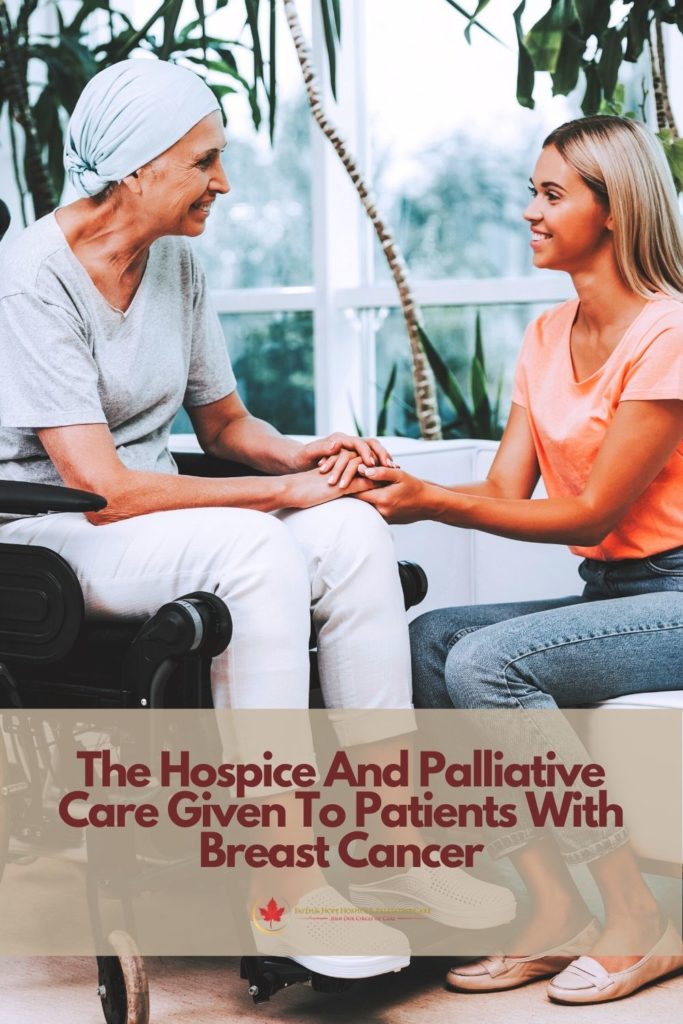
- By: administrator
- Blog
- No Comments
When a person finds out that they have breast cancer, it is frightening and disheartening for the person affecting them and their family. It seems like without warning you are told that you must have chemotherapy, surgery, or radiation. Also, the palliative care team of Faith and Hope in Los Angeles recommends that you make healthcare decisions that involve you and your family. Throughout your fight against breast cancer, you may feel other symptoms such as fatigue, nausea, and anxiety. With all of this going on, it would not be a surprise for anyone at any hospice like those in Pasadena that you feel confounded and confused.

Although there are many advanced treatments for breast cancer, there may come a time when those with metastatic breast cancer start to contemplate hospice care in Los Angeles.
This could occur because curative treatment is no longer an option, or the patient may opt to end curative treatments on their own.
What Are The Symptoms Of Stage 4 Breast Cancer?
Stage 4 breast cancer is the advanced stage of this type of condition, in which the cancer has metastasized. This refers to the spread from the breast to one or more other areas of the body.
Strictly speaking, cancer cells have detached from the original tumor, moved through the bloodstream, and are currently developing somewhere else.
Typical areas of breast cancer metastases include the:
- bones
- brain
- liver
- lungs
- lymph nodes
The symptoms of stage 4 breast cancer can alter and often depend on the place the cancer has spread. Nevertheless, it’s not unusual for a person to experience symptoms such as:
- constipation
- chest wall pain
- shortness of breath
- swelling of the extremities
Presently, there is no cure for stage 4 breast cancer. However, in many instances, options exist to improve quality of life and extend life. For instance, these options include palliative and hospice care. Unfortunately, there are many misconceptions when it comes to hospice and palliative care. This is what you should know to have a better understanding of these options.
What’s The Best Treatment For Metastatic Breast Cancer?
Typically, when patients receiving palliative care make up their minds to change treatment, it is vital to talk about your options with your oncologist. When treatment alternatives are available, patients have to be on the same wavelength as their doctor about quality of life and goals of care. Some things you should discuss about are:
- What is the goal? Is it continued radiation, chemotherapy curative or only to extend life by a few weeks or months?
- What side effects should I expect from that treatment?
- What can I do to lower those side effects?
If a patient receiving palliative care in Los Angeles feels that the side effects of the treatment on hand are not worthwhile for the expected quality of life, they may conclude that it would be in their best interest to discontinue this treatment. This does not necessarily mean that the patient is throwing their hands up in the air and surrendering to cancer, or that there are no treatments available to them. It could mean that they are accepting to focus on their quality of life.
What’s Palliative Care?
Palliative care suggests treating undesirable symptoms of cancer, whether it is physical or emotional ones. Here are some examples of palliative care:
- nonmedical pain management techniques, such as massage, acupressure, and acupuncture
- traditional pain medications, such as over-the-counter (OTC) pain relievers and prescription painkillers
- broader support through community groups, online forums, and email groups
- social and emotional support through loved ones
- overall health and wellness support, diet, and exercise
- religious, spiritual, meditative, or prayer activities
Palliative care’s objective is to help a person feel better while receiving curative treatment.
When Is The Right Time For Palliative Care?
Palliative care is always suitable immediately after the first diagnosis and throughout the course of treatment. Even though this type of care can and should be used together with end-of-life care, palliative care is definitely not only used in those circumstances.
It can be carried out with any recommended treatments that tackle the cancer itself. Also, it can treat unwanted side effects of the cancer treatment.
How Does Palliative Care Help?
The purpose of palliative care is to help a person live their life as fully as they possibly can. Although the cancer treatments work to prolong life, palliative care enhances the quality of that life.
Patients receiving palliative care feel immense comfort during this difficult time with the physical and emotional support they receive.
How’s Hospice Care Different From Palliative Care?
When patients with a terminal diagnosis have no treatment options or choose not to utilize standard treatments, they opt for hospice care.
This type of care consists of a team of professionals as well as medications and other treatments to cope with symptoms, manage side effects, and keep a person as comfortable as possible during the last days and months of their life. Hospice care can be administered in the following settings:
- one’s own home
- a nursing home
- an assisted living facility
When Is Hospice Care Needed?
It is never an easy decision to make, but the earlier hospice care starts, the more advantages a person gets. It is crucial not to delay the commencement of hospice care if it’s required.
When hospice workers have more time to get to know the person and their unique circumstances, the hospice team can go about making a better individualized care plan.
How Does Hospice Care Help?
Hospice care, like that of Faith and Hope serving Pasadena and Los Angeles, makes a person’s transition from actively treating cancer to focusing on staying as comfortable as possible and preparing for their death.
When there are no longer treatment options, it can be reassuring that professional hospice workers will be there to make their remaining time more enjoyable and more comfortable.
Hospice care also plays a big role in helping family members, since they don’t have to handle the responsibility of end-of-life care for their loved one all on their own. Plus, knowing a loved one isn’t in pain can also help make this terribly difficult time a more tolerant one for family and friends.
